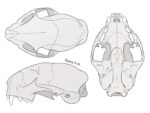Cranial morphological variability of a small Neotropical cat revealed by geometric morphometrics
Raissa Prior Migliorini, Rodrigo Fornel, Carlos B. KasperThe jaguarundi (Herpailurus yagouaroundi) has one of the most extensive latitudinal ranges among felids of the Western Hemisphere. Its wide geographic distribution and range of habitats may result in patterns of cranial morphological variation. Thus, we investigated the hypothesis of the existence of morphological ecotypes adapted to specific environments used by the species. The crania of 54 museum specimens from three different ecoregions in Brazil were digitized in ventral, dorsal, and lateral views. No sexual dimorphism was detected. Our hypothesis was supported by the fact that the specimens from the Amazon were significantly larger than those from the Atlantic Forest and Uruguayan savanna. Cranial shape variation between sexes, as well as among ecoregions, was mostly explained by the effect of size. Correlations between geographical distance and cranial shape were not significant. There was a significant correlation between cranium size and latitude, in a pattern that is the reverse of Bergmann’s rule, with larger specimens in lower latitudes. The environmental variables positively correlated with cranium size indicated that larger cats occurred in regions with greater temperature and precipitation. Resource availability might be the cause of the observed variation in cranium size, since jaguarundis probably show different prey size preferences along the species distribution range. However, more ecological data for most ecoregions are needed to test the “resource rule” and to fully understand the patterns and causes of cranial variation in this cat.
Variabilidade morfológica craniana de um pequeno felino neotropical, revelada pela morfometria geométrica. O jaguarundi (Herpailurus yagouaroundi) possui uma das faixas latitudinais mais extensas entre os felídeos do Hemisfério Ocidental. Sua ampla distribuição geográfica e variedade de habitats podem resultar em padrões de variação morfológica do crânio. Assim, investigamos a hipótese da existência de ecótipos morfológicos adaptados aos ambientes específicos utilizados pela espécie. Os crânios de 54 espécimes de museus de três diferentes ecorregiões no Brasil foram digitalizados nas vistas ventral, dorsal e lateral. Não foi detectado dimorfismo sexual no tamanho. Nossa hipótese foi corroborada, pois os espécimes da Amazônia são significativamente maiores do que os da Mata Atlântica e da Savana uruguaia. A variação da forma do crânio entre os sexos, bem como entre ecorregiões, está correlacionada com a variação de tamanho. Correlações entre distância geográfica e forma do crânio não foram significativas. Houve correlação significativa entre tamanho e latitude, em um padrão inverso da regra de Bergmann, com espécimes maiores observados nas menores latitudes. As variáveis ambientais correlacionadas positivamente com o tamanho indicaram felinos maiores ocorrendo em regiões com maior temperatura e precipitação. A disponibilidade de recursos pode ser a causa da variação de tamanho observada, uma vez que aparentemente o jaguarundi preda presas de tamanhos diferentes ao longo de sua distribuição. Porém, são necessários mais dados ecológicos das demais ecorregiões, para testar a “regra do recurso” e elucidar os padrões e causas da variação do crânio deste felino.
